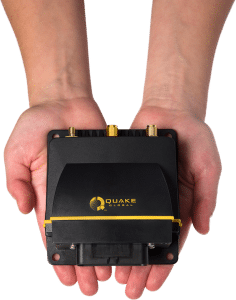
QPRO, Quake Global’s ruggedized product that uses multi-mode communication technologies (satellite, GPS, and cellular). Photo: Quake Global
[Via Satellite 02-19-2016] Quake Global, a provider of communications for asset monitoring and tracking, anticipates that the Internet of Things (IoT) will influence a drawdown of barriers between satellite and other communications technologies. Polina Braunstein, CEO of Quake Global, told Via Satellite that the company is witnessing a push for satellite communications, terrestrial communications and Radio-Frequency Identification (RFID) to be more regularly integrated into single devices. Quake Global produces devices for Machine-to-Machine (M2M) and IoT communications across multiple technologies. Going forward, Braunstein expects these technologies will become less disparate.
“What the user would really like to have are modems that have the ability to use multiple modes of communication. They don’t care if communications happen via satellite, terrestrial, Wi-Fi or any other means of transporting the data. Fundamentally what they need is the data,” she said.
IoT is seen as a growth opportunity across the telecommunications industry, and a growing number of satellite companies are seeking a larger stake in this market. Quake Global provides communications today from Iridium, Orbcomm and Inmarsat — three players already well established in M2M/IoT—along with several Global Navigation Satellite Systems (GNSS). Braunstein said Quake sought out global players with the ability to provide two-way communications. She estimated that approximately 60 percent of the company’s revenue comes from hardware sales, with RFID counting for 30 percent, and custom development the remaining 10.
Braunstein listed heavy machinery, the oil and gas industry, fisheries and marine applications, emergency and military and government applications as the top users of satellite-based IoT today, but she expects satellite will collate with other telecommunications methods in the next few years to reach even more markets.
“I believe that future satellite technologies will enable a variety of different Radio-Frequency (RF) bands to be compiled together. The new technologies will bridge 2G, 3G, 4G, 5G, and Wi-Fi type capabilities into the satellite systems. The new technologies will reduce the infrastructure of the hardware that exists today, and will open up markets in the consumer space, smart city automation, and be a part of smarter technology in general,” she said.
IoT appears to be a driving factor for this technology convergence according to Jeremy Green, principal analyst at Machina Research.
“The current fashion increasingly in Internet of Things is to become more like the Internet, where there is a divorce between access and applications,” Green told Via Satellite. “In a way, these solutions will overtime become more access agnostic, and as that happens, there is definitely a role for more kinds of access technology, whether that is low power technologies like LoRa or like narrowband IoT, which is part of [Third Generation Partnership Project] 3GPP. Satellite is just one more access technology among others.”
Green pointed to recent traction by the satellite industry with the LoRa Alliance as evidence of how satellite is being further integrated into IoT applications. Satellite operator Inmarsat recently joined the LoRa Alliance, which is creating a global, interoperable standard for Low Power Wide Area Networks (LPWAN) for IoT applications. Green said MOOnitor, an IoT cattle monitoring solution (think “Internet of Cows”) is also based on LoRa technology at the local level, with Globalstar providing backhaul.
“I think there is a natural synergy between some of the emerging low power technologies which can be deployed on a mesh basis or on a hub basis in places where there might not be any cellular coverage, and satellite as a backhaul technology,” he said.
“Satellite technology can be complementary to any RF technology today and in the future,” Braunstein added. “Every time you pair satellite technology with any RF technology like cellular, Bluetooth, or Wi-Fi it is a benefit to the customer. Every time you pair satellite and GSM technology, it benefits the customer. There are lot of elements that can be add-ons to satellite technology that enable the customer to convert satellite communications technology to be specific to unique markets and use.”
Braunstein said Quake is investing today in satellite communications technology for global asset tracking, Vehicle to Infrastructure (V2I) capabilities for automotive and M2M markets, and RFID for asset control management and operation. She expects future satellite systems will be better equipped to work with connected vehicles and smart cities/environments.
“I believe that future satellites like OneWeb definitely will have ability to participate in that,” she said.
Braunstein declined to say which new Low Earth Orbit (LEO) satellite operators Quake is collaborating with today, but said the company is participating in multiple discussions with the newer satellite systems.
“The IoT is a market where everything is connected together. You will have the ability to connect to your home appliances, lighting, and security systems. As you get into your vehicle, you will have ability to connect to the vehicle, traffic lights, roadway warnings, etc. You will have the ability to connect to anything you wish to connect to. I do believe that the future satellite technology will address exactly that,” she said.
The post Quake Global CEO Talks Satellite Role in IoT appeared first on Via Satellite.
http://www.satellitetoday.com/telecom/2016/02/19/quake-global-ceo-talks-satellite-role-in-iot/